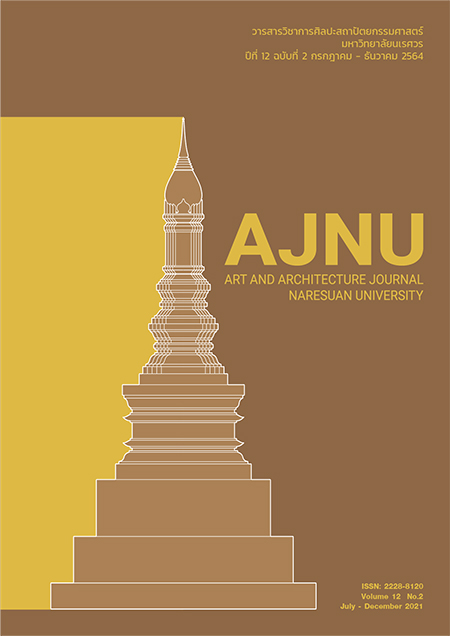The study of light design for the architectural studio at Factory of Architecture, Rajamangala University of Technology Thanyaburi
Main Article Content
Abstract
Lighting is a necessary factor that allow people can see and effective use of space. In the different space,they need a different quality of light. Thus, this study presents the design guideline which can estimate the Illuminance level and can create an understanding of the effects of various factors having important significance to the illuminance by internal natural light as expected. Moreover, this study creates the models in order to analyse and test through the DIAlux program including floor plan, various clerestories, and furniture plan following the actual room which has the mean of internal reflective light as 0.00 lux to 1,111.00 lux from the maximum amount of light (lux). This research has tested in a room based on a mock-up condition and light under the real sky condition. In additional, the assessments are separated into 2 ways: a quantitative and qualitative assessment. The result of research found that the comparison between natural light and artificial light pointed out that choosing the types of artificial light the amount of proper light inside the area By the standard criteria of using lighting in the classroom that has used computer is 300 to 500 lux. It could be concluded that the proportion of internal illuminance has the most suitability to be utilized. Thus, the LED is one of the artificial light types which is the best application for usage in the classroom. It can be increased internally lighting as provided the greatest quantity and stability specification. The result from this research will be the beneficial information for the estimating light design which can actually and internally be occurred following the academic aspect with the alternative choices of application in the classroom.
Article Details
References
https://www.scimath.org/lesson-physics/item/7277- 2017-06-13-14-42-30.
ตรีชิต เลิศวัฒนาสมบัติ. (2551). การจัดการสิ่งแวดล้อมเพื่อในระบบสำนักงานอัตโนมัติ เข้าถึงได้จาก :
http://paingpain.blogspot.com/2008/11/blog-post.html
บริษัท ฟิลิปส์ ประเทศไทย จํากัด. (2562). ลักษณะหลอดไฟแอลอีดี และหลอดฟลูออเรสเซ้นต์ เข้าถึงได้จาก :
https://www.phillips.com/
พิบูลย์ ดิษฐ์อุดม. (2528). การออกแบบระบบแสงสว่าง. กรุงเทพฯ: สถาบันเทคโนโลยีพระจอมเกล้าธนบุรี,
วิมลสิทธิ์ หรยางกูร, (2541). พฤติกรรมมนุษย์กับสภาพแวดล้อม. กรุงเทพฯ: สำนักพิมพ์แห่งจุฬาลงกรณ์มหาวิทยาลัย.
สุนทร บุญญาธิการ. (2539). วัสดุประหยัดพลังงาน. กรุงเทพฯ: สถาบันวิจัยพลังงาน
สมาคมไฟฟ้าแสงสว่างแห่งประเทศไทย. (2559). คู่มือแนวทางการออกแบบการส่องสว่างภายในอาคาร (Guidelines for Indoor Lighting Design). เข้าถึงได้จาก: http://www.tieathai.org/images/intro_1479229183/final.Guidelines_BW
สภาวิศวกร. (2558). แนวทางการออกแบบกรอบอาคาร. เข้าถึงได้จาก:
http://www.thaiengineering.com/2015/index.php/technology/item/461-building-envelope-design
อานิก สกุลญานนท์วิทยา. (2544). การจัดวางแสงประดิษฐ์ให้สัมพันธ์กับผังห้องเรียนเพื่อเพิ่มประสิทธิภาพการใช้พลังงาน. กรุงเทพฯ: จุฬาลงกรณ์มหาวิทยาลัย. คณะสถาปัตยกรรมศาสตร์
อรพันธุ์ ประสิทธิรัตน์. (2534) การศึกษาสภาพแวดล้อมทางการเรียนของนิสิตคณะศึกษาศาสตร์มหาวิทยาลัยศรีนครินท
รวิโรฒ. กรุงเทพฯ: ภาควิชาเทคโนโลยีทางการศึกษา คณะศึกษาศาสตร์ มหาวิทยาลัยศรีนครินทรวิโรฒ ประสานมิตร.
DIALux Light Building Software. (2012). DIALux 4 with new improved calculation kernel. Retrieved
December 12, 2012, from: http://www.dial.de/DIAL/fileadmin/download/ dialux/wissen/
Dx4_Rechenkern_eng.pdf
Lechner, N. Heating Cooling. Lighting : Ddsign Methods for Architects. New York :John Wiley & Sons,1991.
Mc Vey, G. F. (1989) การจัดสภาพแวดล้อมการเรียนรู้ในห้องคอมพิวเตอร์. 2556, from http://56540111-
402.blogspot.com/2013/07/blog-post.html
Moore, Adam. D. Intellectual Property & Information Control Philosophic Foundations and
Contemporary Issues. New Jersey: Transaction Publishers, 2001.
Saxon, R Atrium Building Development and Design. Second Edition. London : Bas Printera, 1986
Stein, B., and Reynolds, J. Mechanical and Electrical Equipment for Buildings. 8th Edition. New York:
John Wiley & Sons, 1992.

